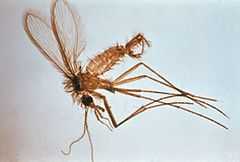Phlebotomus
| Phlebotomus | |
|---|---|
 | |
| A male Phlebotomus fly | |
| Scientific classification | |
| Kingdom: | Animalia |
| Phylum: | Arthropoda |
| Class: | Insecta |
| Order: | Diptera |
| Family: | Psychodidae |
| Subfamily: | Phlebotominae |
| Genus: | Phlebotomus Loew 1845 |
| Species | |
|
P. alexandri | |
Phlebotomus is a genus of "sand flies" in the Diptera family Psychodidae. In the past, they have sometimes been considered to belong in a separate family, Phlebotomidae, but this alternative classification has not gained wide acceptance.[1]
Epidemiology

In the Old World, Phlebotomus sand flies are primarily responsible for the transmission of leishmaniasis,[2] an important parasitic disease, while transmission in the New World, is generally via sand flies of the genus Lutzomyia.[3] The protozoan parasite itself is a species of the genus Leishmania. Leishmaniasis normally finds a mammalian reservoir in rodents and other small animals such as canids (canine leishmaniasis) and hyraxes. The female sand fly carries the Leishmania protozoa from infected animals after feeding, thus transmitting the disease, while the male feeds on plant nectar.
Phlebotomus species are also vectors for bartonellosis, verruga peruana, pappataci fever, an arbovirus caused by sandfly fever viruses such as Naples and Sicilian strains, which are members of the genus Phlebovirus (family Bunyaviridae), which also includes the closely related Toscana virus.[4][5] In Egypt, two species of medical importance are Phlebotomus papatasii and P. langerni. These flies are short-lived. Females are bloodsuckers at night; males feed on plant juices. Adults are poor fliers, they usually hop for short distances.
Morphology
Adults are about 1.5–3.0 mm long and yellowish in colour, with conspicuous black eyes, and hairy bodies, wings, and legs. The oval lanceolate wings are carried erect on the humped thorax. Males possess long prominent genital terminalia known as claspers. Females have a pair of anal recti.
Lifecycle
Females lay eggs in batches in cracks and crevices which are dark and rich in organic matter. They are small, elliptical, and brownish in colour. Hatching occurs into the larval stage. Larvae are small whitish in colour with a black head capsule. Characteristic of this species is a pair of long, dark caudal bristles which arise from the posterior end.
References
- ↑ BDWD Family List
- ↑ 2.0 2.1 Aoun, K.; Bouratbine, A. (2014). "Cutaneous Leishmaniasis in North Africa: a review.". Parasite 21: 14. doi:10.1051/parasite/2014014. PMC 3952656. PMID 24626301.
- ↑ Zeledón RA (1996). Hemoflagellates: Cutaneous and Mucocutaneous Leishmaniasis. In: Barron's Medical Microbiology (Barron S et al., eds.) (4th ed.). Univ of Texas Medical Branch. (via NCBI Bookshelf) ISBN 0-9631172-1-1.
- ↑ Shope RE (1996). Bunyaviruses. In: Barron's Medical Microbiology (Barron S et al., eds.) (4th ed.). Univ of Texas Medical Branch. (via NCBI Bookshelf) ISBN 0-9631172-1-1.
- ↑ Valassina M, Cusi MG, Valensin PE (2003). "A Mediterranean arbovirus: the Toscana virus". J Neurovirol 9 (6): 577–83. doi:10.1080/13550280390247678. PMID 14602570.